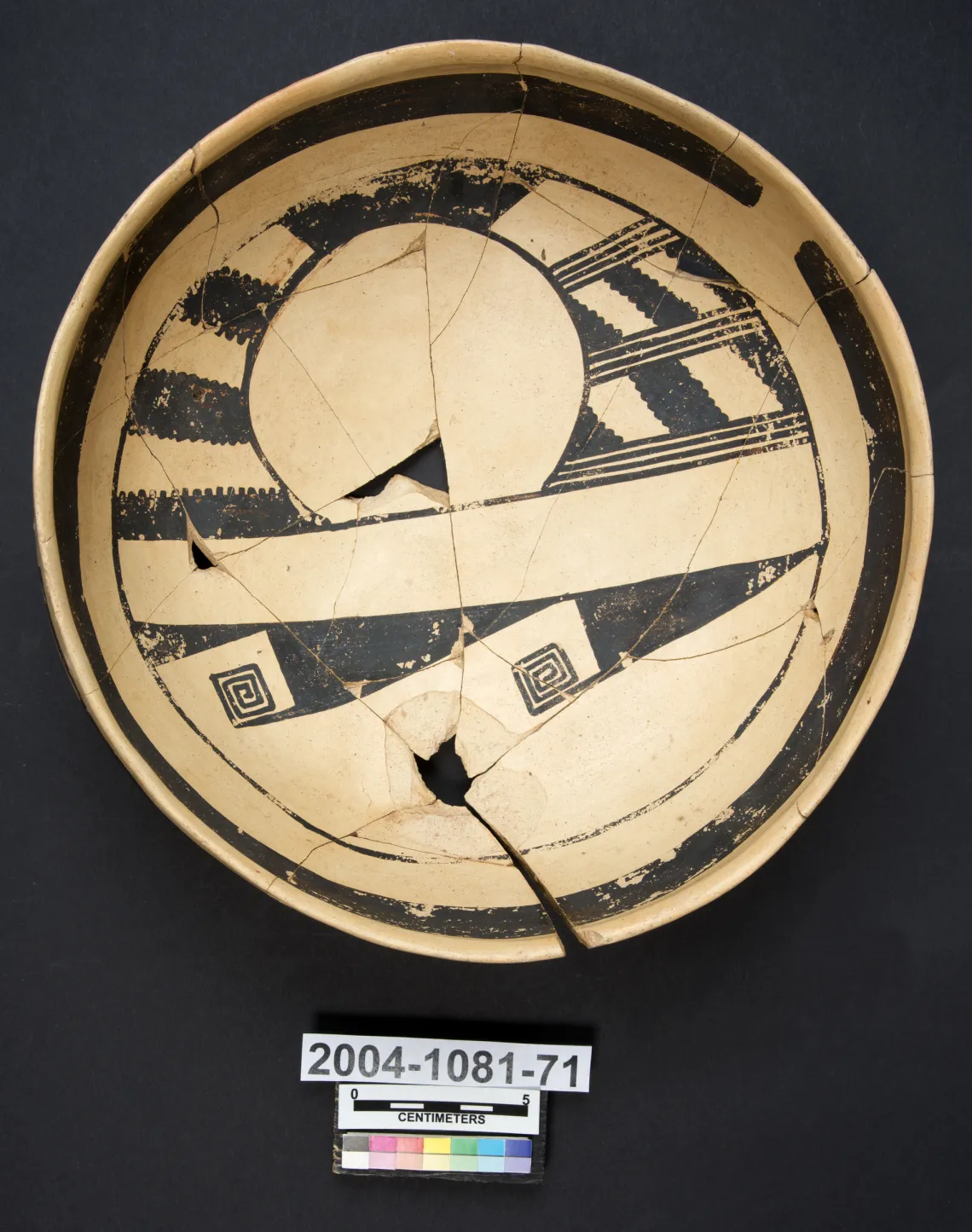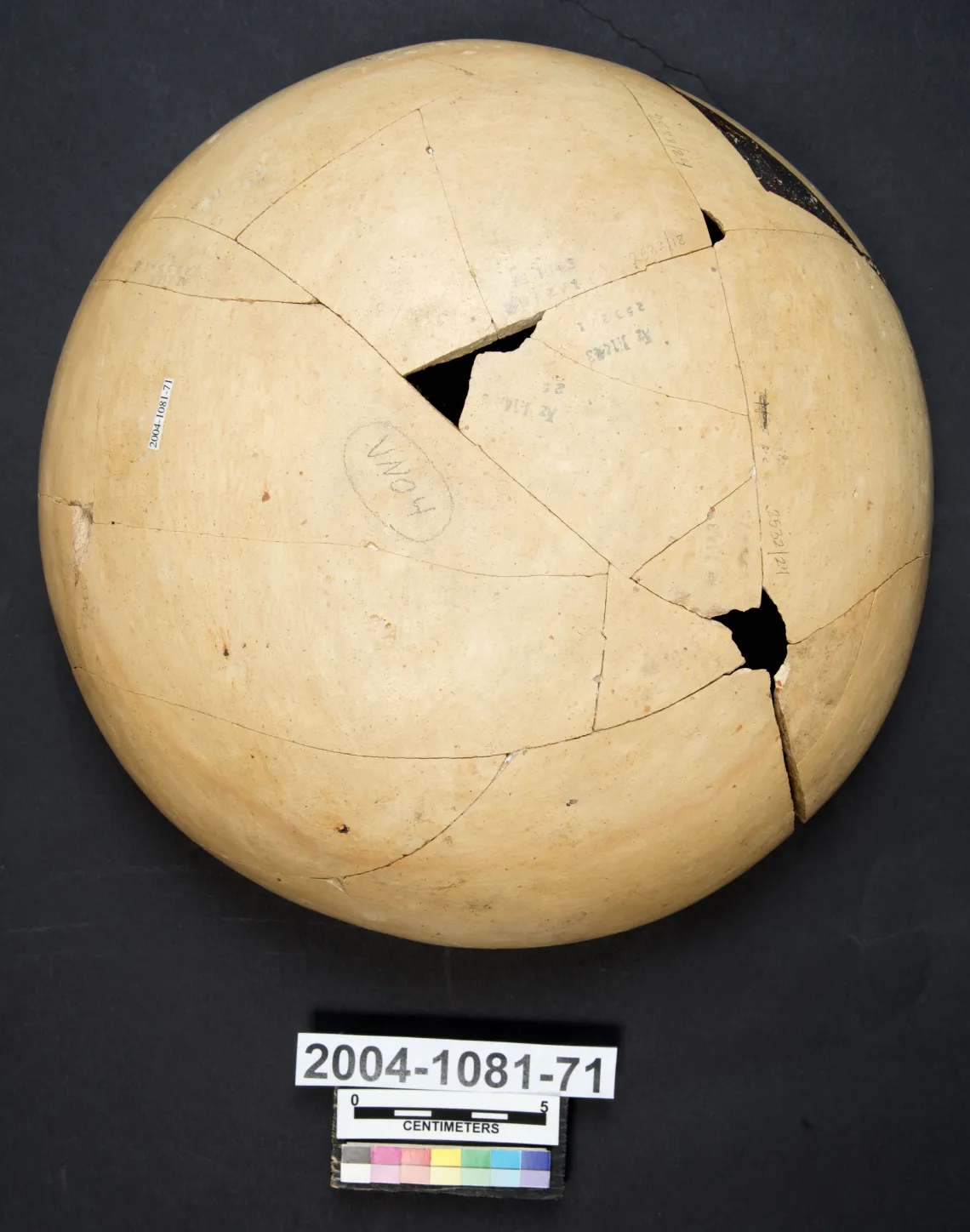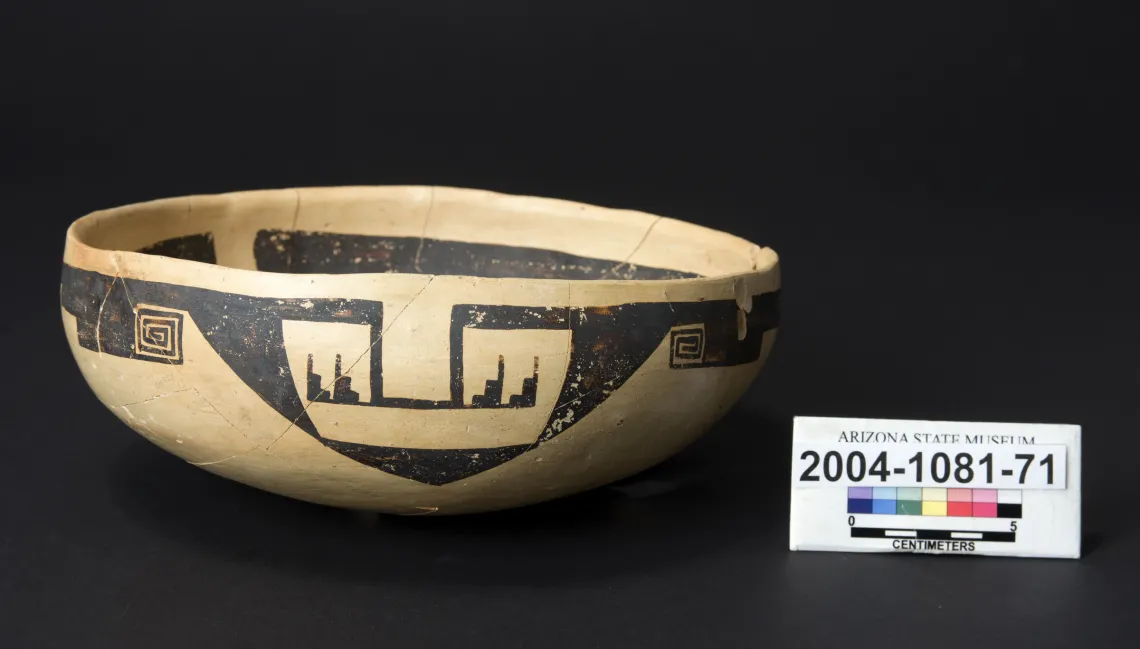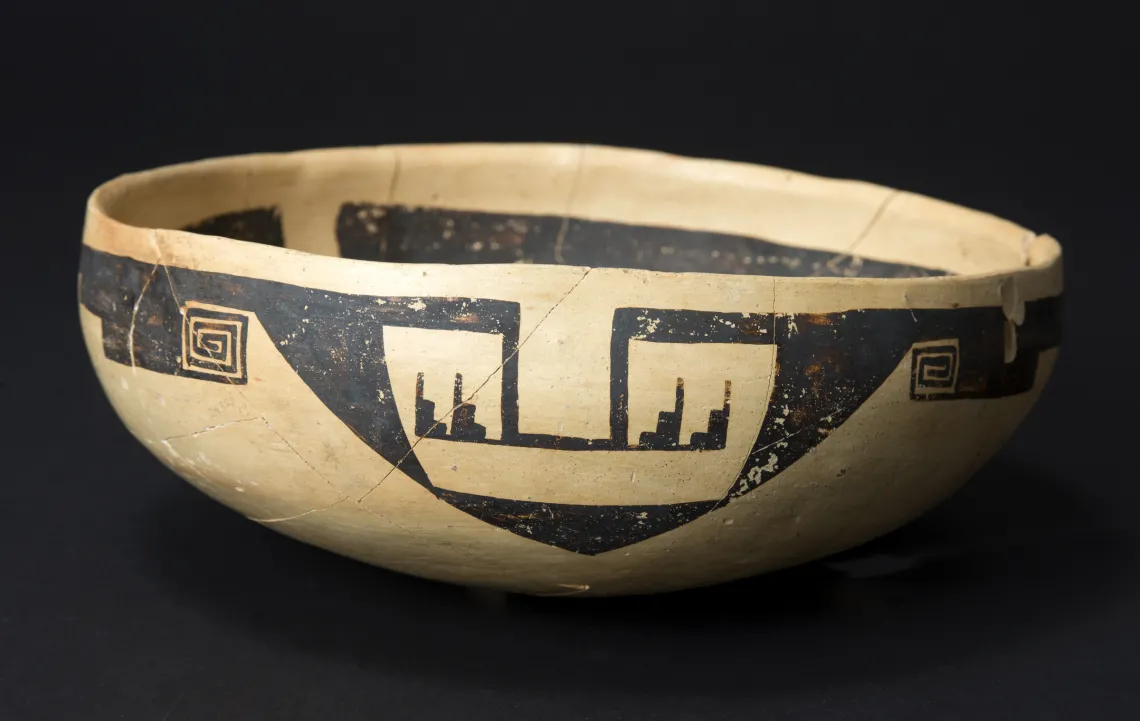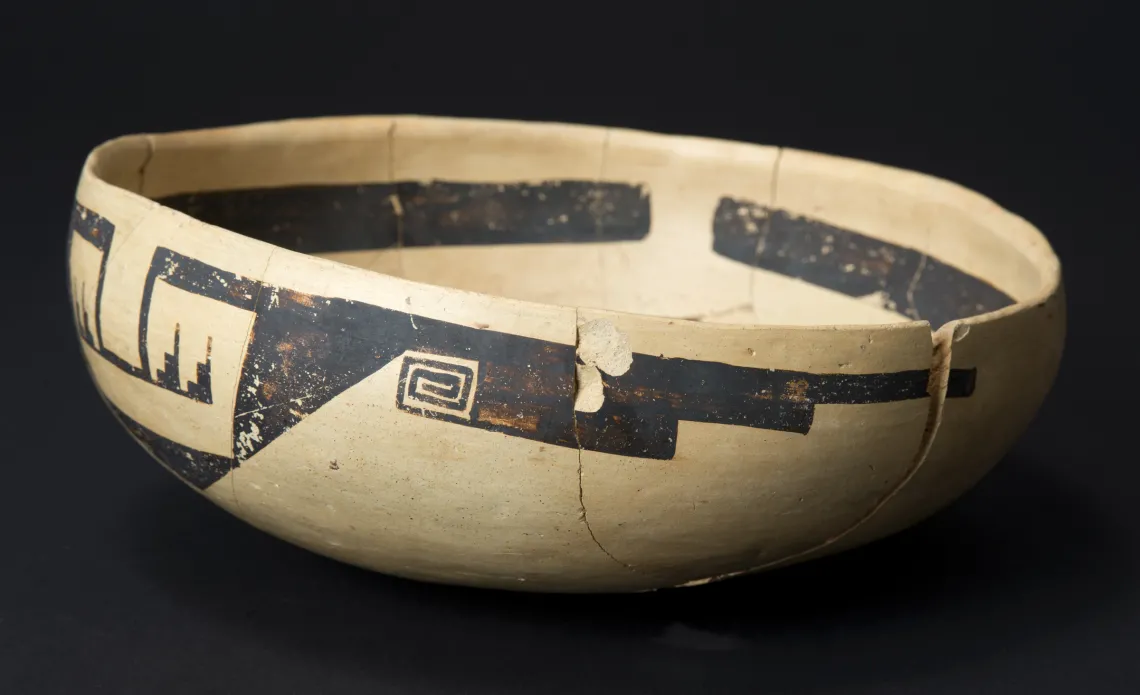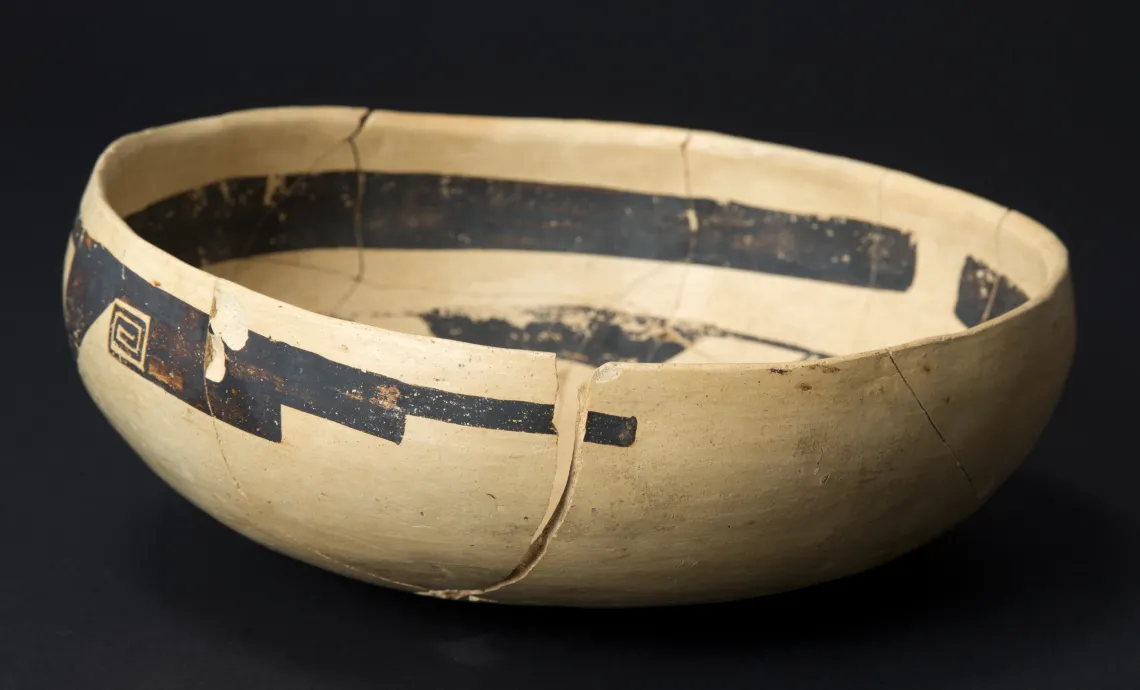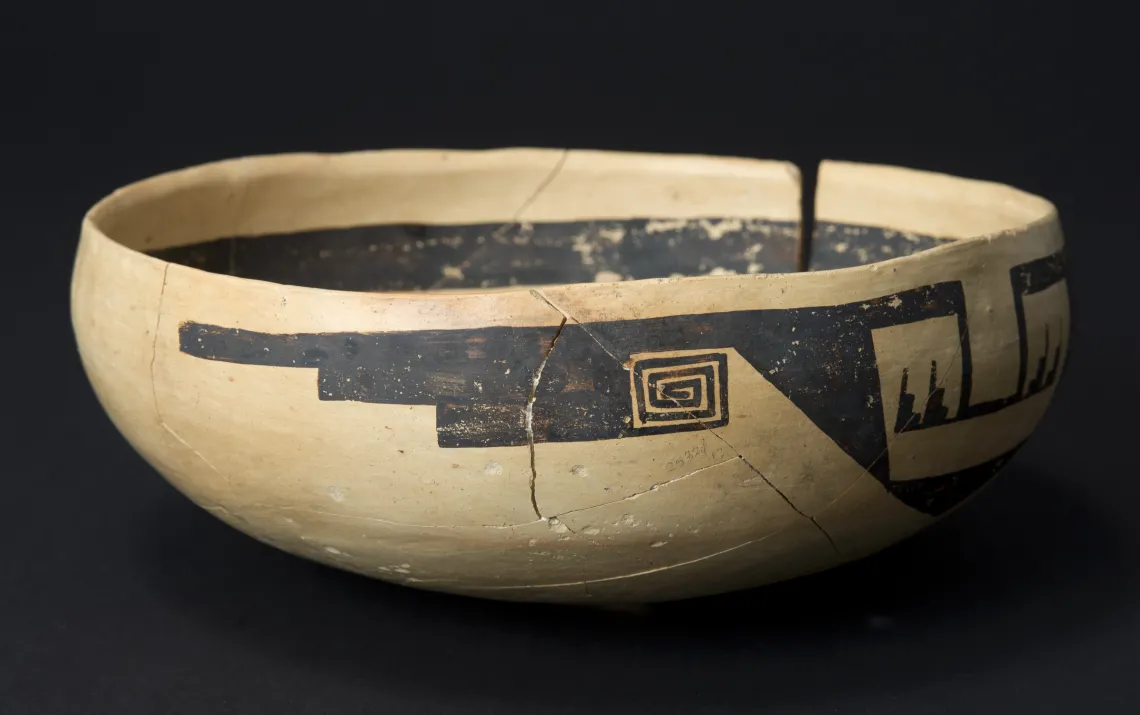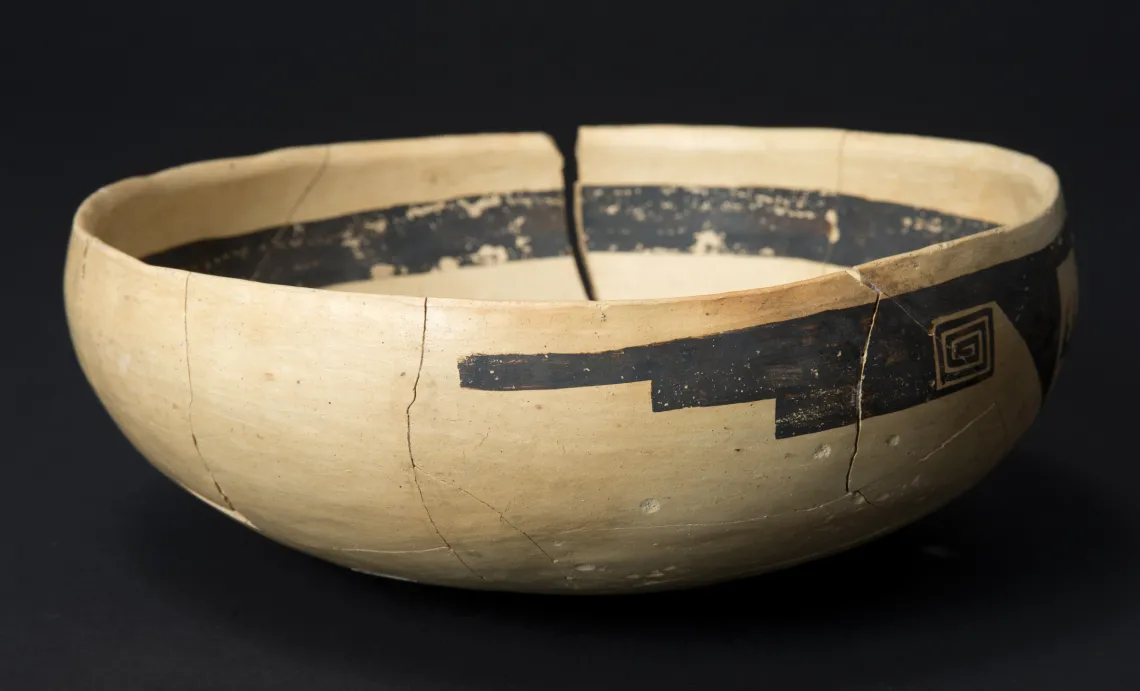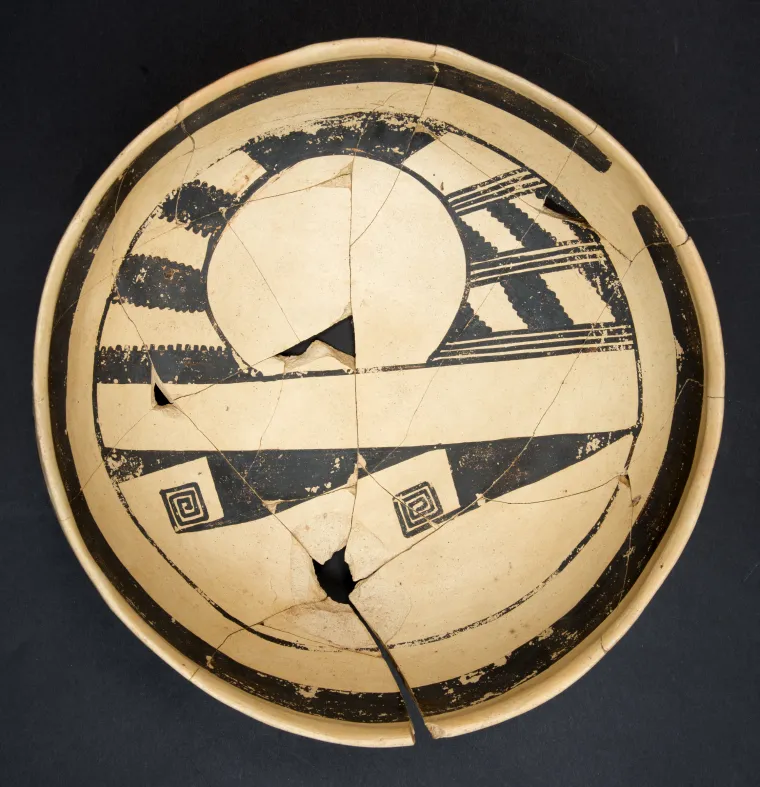
See more of this object in the slideshow below
Jeddito Black-on-yellow Bowl
1365–1400 C.E.
Ancestral Pueblo (Anasazi)
Pueblo IV Period
Structure 556, Homol’ovi I (AZ J:14:3[ASM]), near Winslow, northeastern Arizona
Ceramic
Height: 3.4 in. (8.6 cm.), Diameter: 8.7 in. (22.1 cm.)
Excavated in 1999 by ASM, under project director E. Charles Adams
(ASM Catalog No. 2004-1081-71)
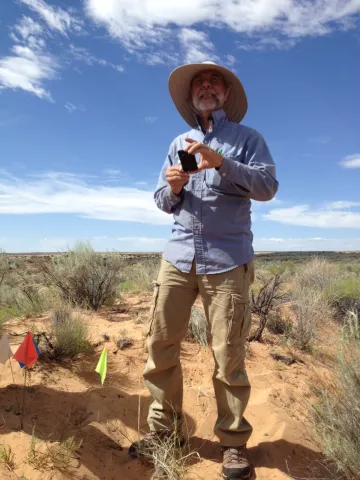
Text by Dr. E. Charles Adams, Curator of Archaeology, October 2013
This is one of five purposely broken bowls found in the fill of a room at the ancestral Hopi pueblo called Homol'ovi I. They were likely deposited when the last groups were leaving Homol’ovi I for the Hopi Mesas, 60 miles to the north. Homol’ovi I is one of seven villages that form the Homol’ovi Settlement Cluster along the Little Colorado River, near Winslow, Arizona. It, along with Homol’ovi II, III, and IV, is incorporated into Homolovi State Park.
People living on the Hopi Mesas had access to seams of coal, and Hopi potters are the only ones in North America to have used coal to fire pottery. They still do today. The very high temperature, 1700–2000 °F (925–1090°C), produced by coal yields a high quality product that was much desired as a trade item throughout the ancient Southwest. Indeed, although most Jeddito Yellow Ware is found in northeastern Arizona, it has been recovered as far from the Hopi Mesas as southeastern Utah, northwestern Chihuahua, Los Angeles, California, and southwestern Oklahoma.This bowl, along with tens of thousands of others, was traded to the Homol’ovi villages for cotton and aquatic plants and animals from the Little Colorado River and its tributaries.
The interior design of the bowl is split into two uneven parts. The designs above the central lines possibly represent the sun, with its rays intersecting or highlighting clouds and rain. The sun appears to be setting or rising on the landscape depicted by two parallel lines. Images beneath the two parallel lines may be below the ground and represent animals, or plants sprouting. A similar dichotomy is often represented in kiva murals at Awat’ovi and Kawàyka’a, villages on Antelope Mesa with occupations overlapping that of Homol’ovi I.
The wide “banding line” below the rim of the vessel has an intentional break, typical of all yellow ware bowls of this period. Modern Hopi potters interpret the break as necessary to prevent the bowl's life force or spirit from becoming trapped. The distance from the banding line to the rim varies over time. On earlier bowls, the line is adjacent to the rim and on later ones it is progressively farther away.
The beautifully rendered exterior design also likely represents clouds and rain. This specific exterior design appears on other yellow ware vessels at Homol’ovi and at villages on the Hopi Mesas, leading to speculation that such embellishments functioned as maker’s marks, signifying the pottery making group who produced these vessels.
From its founding, at about 1290, to 1365, Homol’ovi I was the largest and most important village in the Homol’ovi cluster. With the founding of Homol’ovi II, circa 1365, Homol’ovi I was likely surpassed. Each village had more than 1000 rooms at its peak. Jeddito Yellow Ware (named for a valley south of Antelope Mesa) began to be manufactured by 1325 on the Hopi Mesas. Soon great surpluses of this prized, coal-fired ceramic were being made and exchanged for products from throughout the Southwest, especially the Homol’ovi villages. Neutron activation analysis, which reveals the chemical makeup of the clay, indicates that 75% of yellow ware found at Homol’ovi I was produced in villages on Antelope Mesa, with 53% from Awat’ovi. From this analysis and the bowl's decoration, we deduce that it was likely brought to Homol’ovi I from an Antelope Mesa village sometime after 1365. The trading partners likely knew each other and may have been related.
The bowl shows only light use on the bottom and was intact until its purposeful destruction at about 1400. It was recovered from the uppermost layer of deposits in a room that had been filled with trash, likely by the inhabitants of adjacent households. This bowl and the others found with it were inverted on top of the accumulated layers of trash and struck on their bottoms, shattering them in place. Hopi oral history indicates that when groups were leaving a village, they would purposely break all of the pottery they could not take with them, leaving evidence of who once lived there. Such intentional breakage of pottery is not common either in the Homol’ovi assemblages or in the ASM collections, but other examples are present.
Hover your mouse over the image to halt the slideshow
References
Printing this page will display URLs for links to citations.
Adams, E. Charles
- 1991 The Origin and Development of the Pueblo Katsina Cult. University of Arizona Press, Tucson.
- 2002 Homol’ovi: An Ancient Hopi Settlement Cluster. University of Arizona Press, Tucson.
Adams, E. Charles, Vincent M. LaMotta, and Kurt Dongoske
- 2004 Hopi Settlement Clusters Past and Present. In The Protohistoric Pueblo World: A.D. 1275–1600, edited by E. Charles Adams and Andrew I. Duff, pp. 128–136.
Adams, E. Charles, Miriam T. Stark, and Deborah Dosh
- 1993 Ceramic Distribution and Exchange: Jeddito Yellow Ware and Implications for Social Complexity. Journal of Field Archaeology 20:3–21. University of Arizona Press, Tucson.
Bernardini, Wesley
- 2005 Hopi Oral Tradition and the Archaeology of Identity. University of Arizona Press, Tucson.
- 2007 Jeddito Yellow Ware and Hopi Social Networks. Kiva 72:295–328.
Bishop, Ronald L., Veletta Canouts, Susan De Atley, Alfred Qöyawayma, and C.W. Aikins
- 1988 The Formation of Ceramic Analytical Groups: Hopi Pottery Production and Exchange, A.D. 1300–1600. Journal of Field Archaeology 15:317–337
Hays, Kelley Ann
- 1991 Ceramics. In Homol'ovi II: Archaeology of An Ancestral Hopi Village, Arizona, edited by E. Charles Adams and Kelley Ann Hays, pp. 23–48. Anthropological Papers of the University of Arizona No. 55. University of Arizona Press, Tucson.
- 1994 Kachina Depictions on Prehistoric Pueblo Pottery. In Kachinas in the Pueblo World, edited by Polly Schaafsma, pp. 47–62. University of New Mexico Press, Albuquerque.
Hays-Gilpin, Kelley A., and Steven A. LeBlanc
- 2007 Sikyatki Style in Regional Context. In New Perspectives on Pottery Mound Pueblo, edited by Polly Schaafsma, pp. 109–136. University of New Mexico Press, Albuquerque.
LeBlanc, Steven A., and Lucia Henderson
- 2009 Symbols in Clay: Seeking Artists’ Identities in Hopi Yellow Ware Bowls. Papers of the Peabody Museum of Archaeology and Ethnology, vol. 84. Peabody Museum Press, Cambridge.
Lyons, Patrick D.
- 2003 Ancestral Hopi Migrations. Anthropological Papers of the University of Arizona, No. 68. University of Arizona Press, Tucson.
Smith, Watson
- 1971 Painted Ceramics of the Western Mound at Awatovi. Papers of the Peabody Museum of Archaeology and Ethnology, vol. 38, Harvard University, Cambridge.
Wade, Edwin L., and Lea S. McChesney
- 1982 Historic Hopi Ceramics: The Thomas Keam Collection of the Peabody Museum of Archaeology and Ethnology, Harvard University. Peabody Museum Press, Cambridge.
About Coal-firing of Jeddito Yellow Ware
Bartlett, Katharine
- 1935 Prehistoric Mining in the Southwest. Museum Notes 7(10):41–44.
Brew, J. O., and John T. Hack
- 1939 Prehistoric Use of Coal by Indians of Northern Arizona. Plateau 12(1):8–14.
Colton, Harold S.
- 1936 Hopi Coal Mines. Museum Notes 8(12):59–61.
- 1939 Primitive Pottery Firing Methods. Museum Notes 11(10):63–66.
- 1951 Hopi Pottery Firing Temperatures. Plateau 24(2):73–76.
- 1953 Potsherds: An Introduction to the Study of Prehistoric Southwestern Ceramics and Their Use in Historic Reconstruction. Museum of Northern Arizona Bulletin No. 25. Northern Arizona Society of Science and Art, Flagstaff.
Hack, John T.
- 1942 Prehistoric Coal Mining in the Jeddito Valley, Arizona. Papers of the Peabody Museum of American Archaeology and Ethnology, vol. 35(2). Harvard University, Cambridge.
Hodge, Frederick W.
- 1904 Hopi Pottery Fired with Coal. American Anthropologist 6(4):581–582.
Shepard, Anna O.
- 1971 Technological Note on Awatovi Pottery. In Painted Ceramics of the Western Mound at Awatovi, by Watson Smith, pp. 179–184. Papers of the Peabody Museum of Archaeology and Ethnology, vol. 38. Harvard University, Cambridge.
About the Far-flung Distribution of Jeddito Yellow Ware
Baugh, Timothy G., and Fern E. Swenson
- 1982 The Pottery of Edwards I. In Edwards I (34BK2): Southern Plains Adaptations in the Protohistoric Period, by Timothy G. Baugh, pp. 51–108. Studies in Oklahoma’s Past No. 8. Oklahoma Archaeological Survey, University of Oklahoma, Norman.
Kinnear-Ferris, Sharyl
- 2011 Hopi Pottery in the Southern Utah Canyon Country. Paper presented at the 76th Annual Meeting of the Society for American Archaeology, Sacramento.
Schaefer, Paul D.
- 1969 Prehistoric Trade in the Southwest and the Distribution of Pueblo IV Hopi Jeddito Black-on-yellow. Kroeber Anthropological Society Papers 41:54–77.






